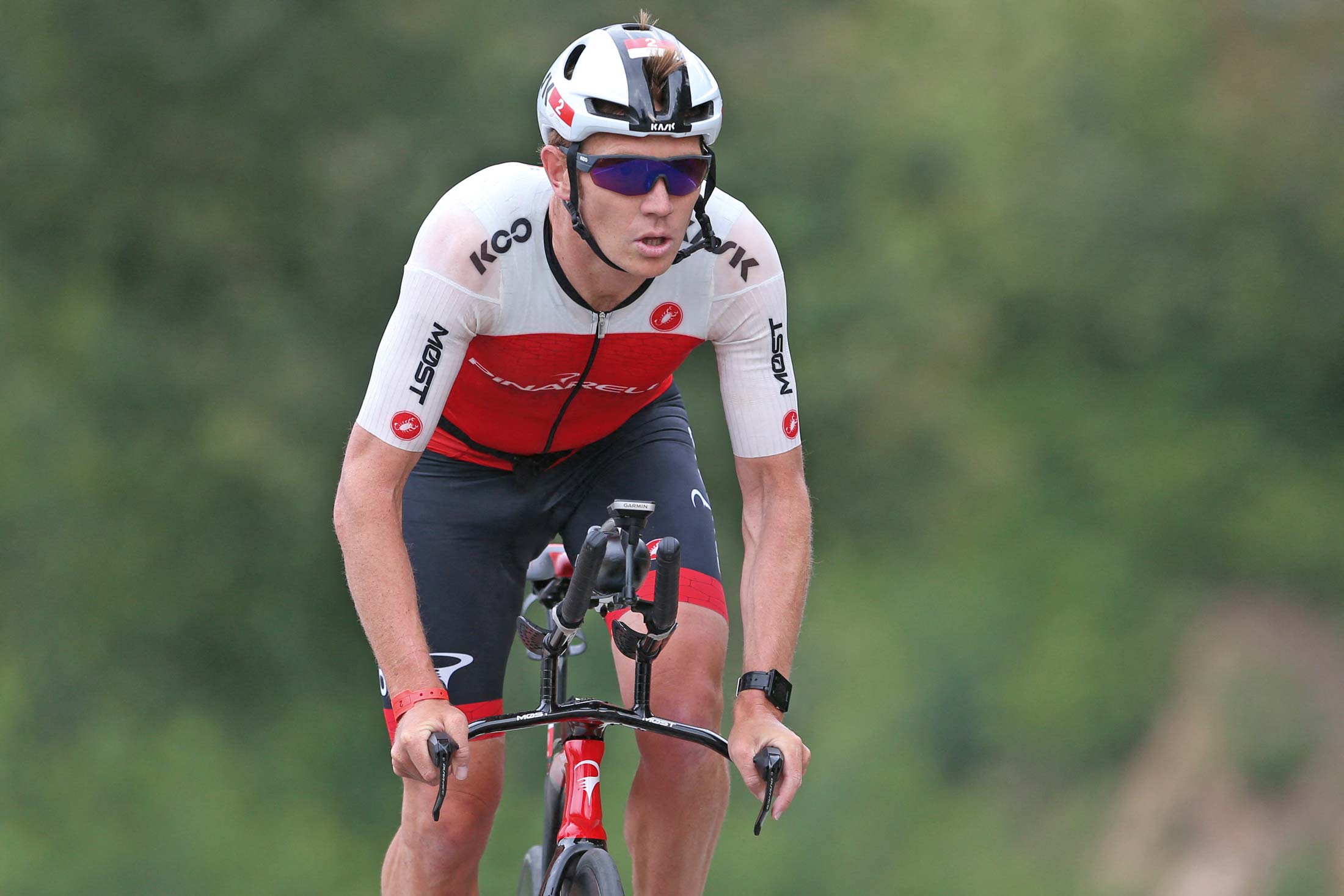He’s rowed at the Olympics, raced in cycling’s WorldTour, and set records at Kona Ironman.
In 2019 Cameron Wurf calls himself a triathlete and a partnership with Chris Froome and Team Ineos has helped nurtur his winning ways.
We speak to the versatile Tasmanian athlete to find out what it’s like training with champions of the Tour de France.
– This was originally published in the 2019 Official Tour de France Guide (Australian edition), June 2019 –
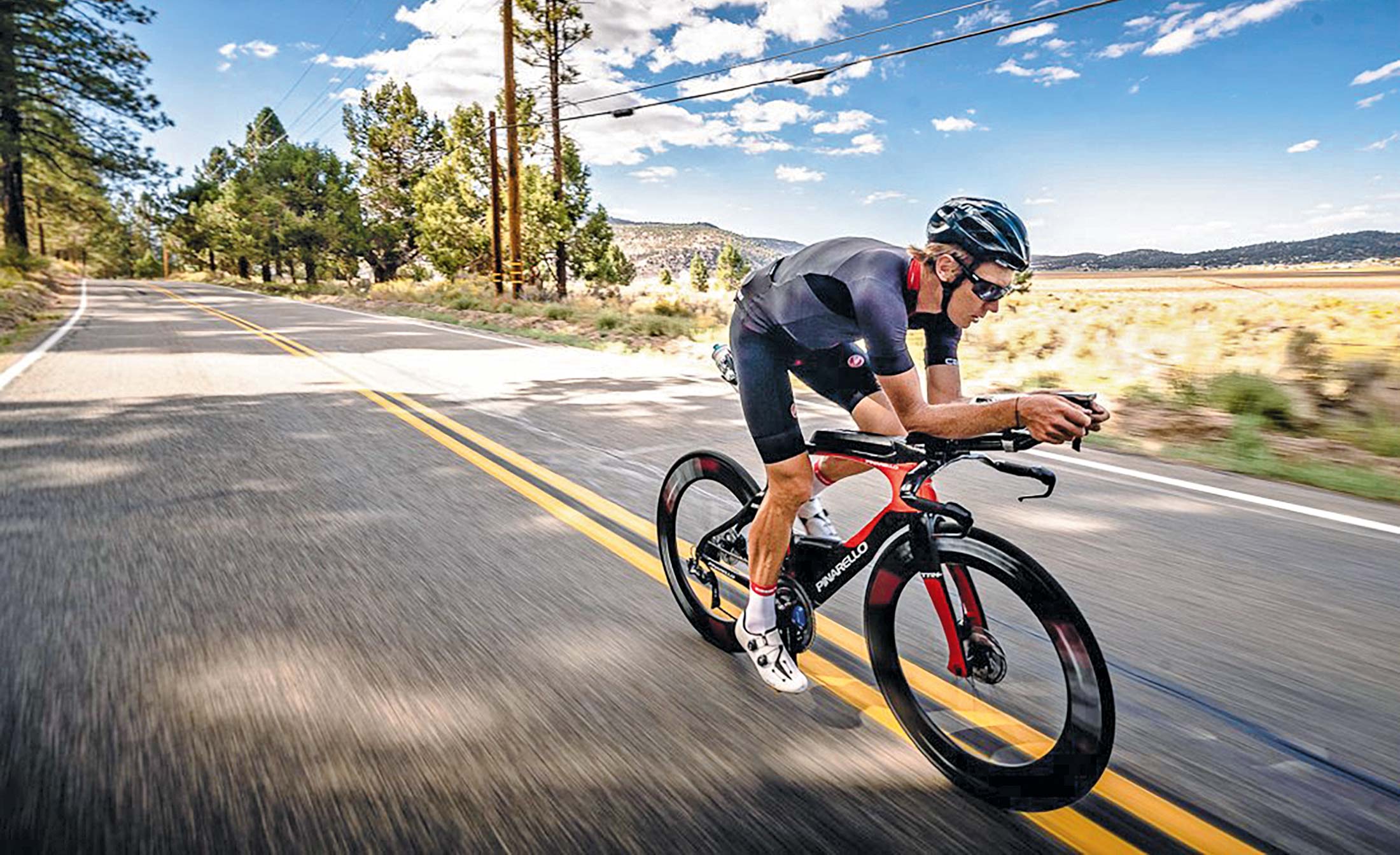
– By Rob Arnold
Two days after Ironman Australia the winner, Cameron Wurf, is happy to talk… about the Tour de France. He set a new course record on the day of his victory in Port Macquarie, and the next weekend he would marry Fallon Farley in the first of two ceremonies: one with his family in Tasmania, the next at Deep Creek Lake, her hometown in Maryland. He’s in Sydney for a few hours, will soon fly to Hobart, then it’s off to the States, the wedding, and onwards to the next triathlon. He has a base in Andorra, spends time in California, and often rides with Chris Froome and others from Team Ineos up Mount Teide on Tenerife.
It’s easy to speak with Wurf, who loves a chat and seems able to make time for everyone, but it’s difficult to keep up with him.
Sport has given him a global lifestyle and it’s not just his latest obsession, triathlon, that keeps him busy. He has plenty on his mind – he usually does – but he’s happy to explain his connection with two champions of the Tour.
In 2019, Wurf is effectively the 30th member of Team Ineos; he doesn’t race with them even if that idea has been floated since he first joined Froome, coach Tim Kerrison, and others from the British team.
What was meant to be a 10-day session has continued, and turned into a multi-sport friendship. In two-and-a-bit years, the Olympic rower who switched to being a pro cyclist for almost a decade, has become a close confidant of the four-time Tour champion.
Through his partnership with Froome, Wurf has got to know Geraint Thomas and many others who are about to begin another campaign to win the Tour de France. You won’t see him at the front of the bunch… but Wurf has become a trusted member of an elite cycling team.
“I’m often a substitute for whoever is not there,” he says in summary of his role in training sessions.
So, how did this all happen? And what does this versatile 35-year-old have to do with Froome, Thomas, Kerrison and the Tour? That was the broader theme of our discussion in May.
He is now one of the favourites for the Kona Ironman but Wurf’s side project is working with two cyclists who have recently won the world’s biggest bike race. How did he get here?
“I got a call out of the blue from Tim Kerrison,” explains Wurf about the sequence that led him to become Ineos’ latest Australian connection.
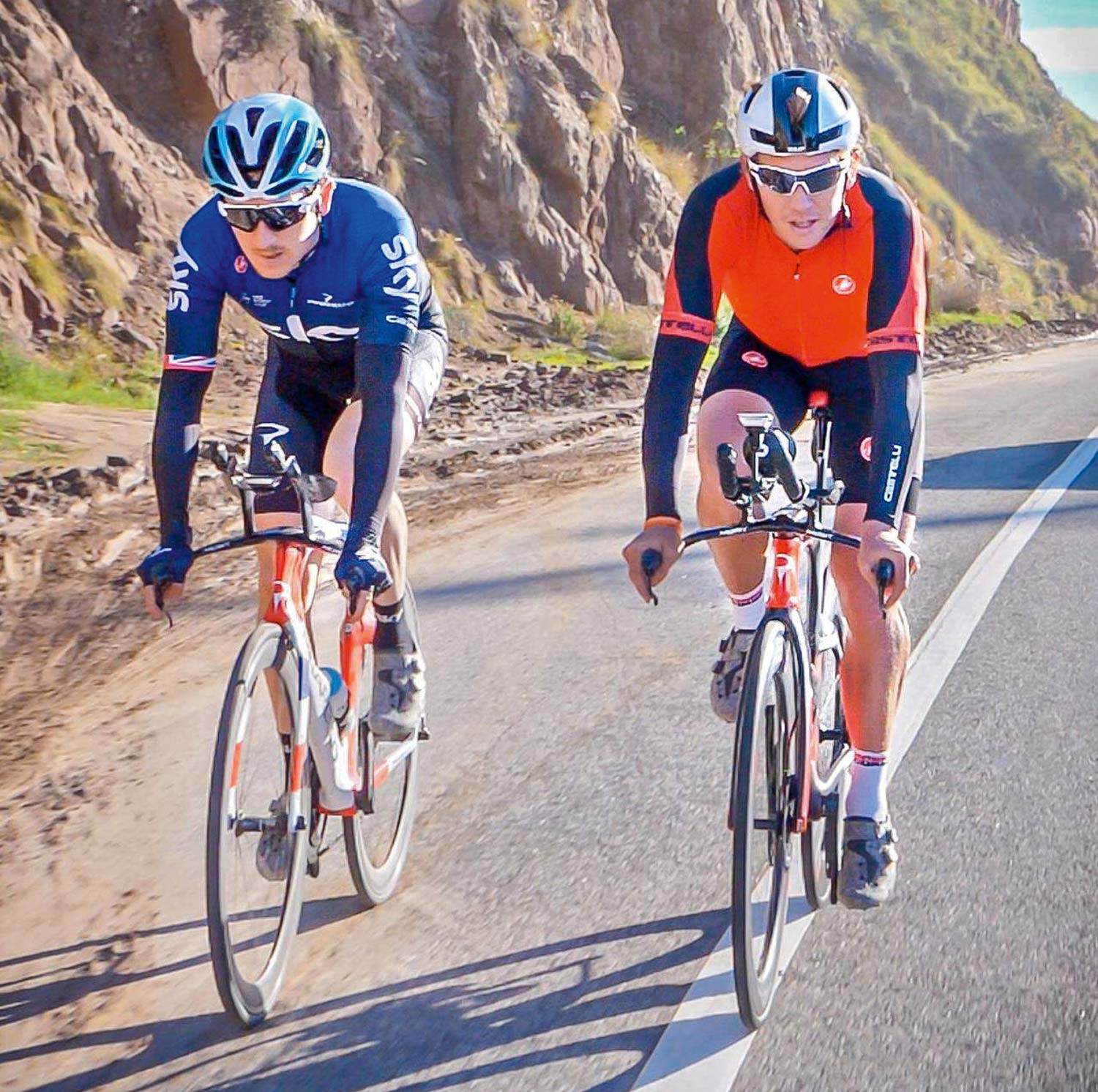
Cam Wurf is blazing a trail in his third sport: triathlon. Tim Kerrison also enlisted the Tasmanian to help when training the likes of Chris Froome and Geraint Thomas (above).
“I’d been dabbling in triathlon in 2016 but was more focussed on working in finance in the States; a dream of mine is to work on Wall Street.
“But Tim rang and said, ‘What are you up to?’
“I was in Hobart and I replied, ‘Not much.’
“He then asked, ‘Would you like to come and train with Chris Froome and keep him company for 10 days?’
“I said, ‘Yeah, why not?’
“I had nothing else to do and it was something I could do in cycling that was like a last hurrah, a bit of a swansong from elite sport. And what an opportunity: to train with the three-time Tour de France champion – at that point – and one of the greatest endurance coaches ever, in Tim Kerrison, with his background in the same sports I’m involved in.”
And so it began: Wurf met Froome and the rest, as they say, is history.
“In that 10 days, I didn’t really miss a beat, particularly from a training perspective.”
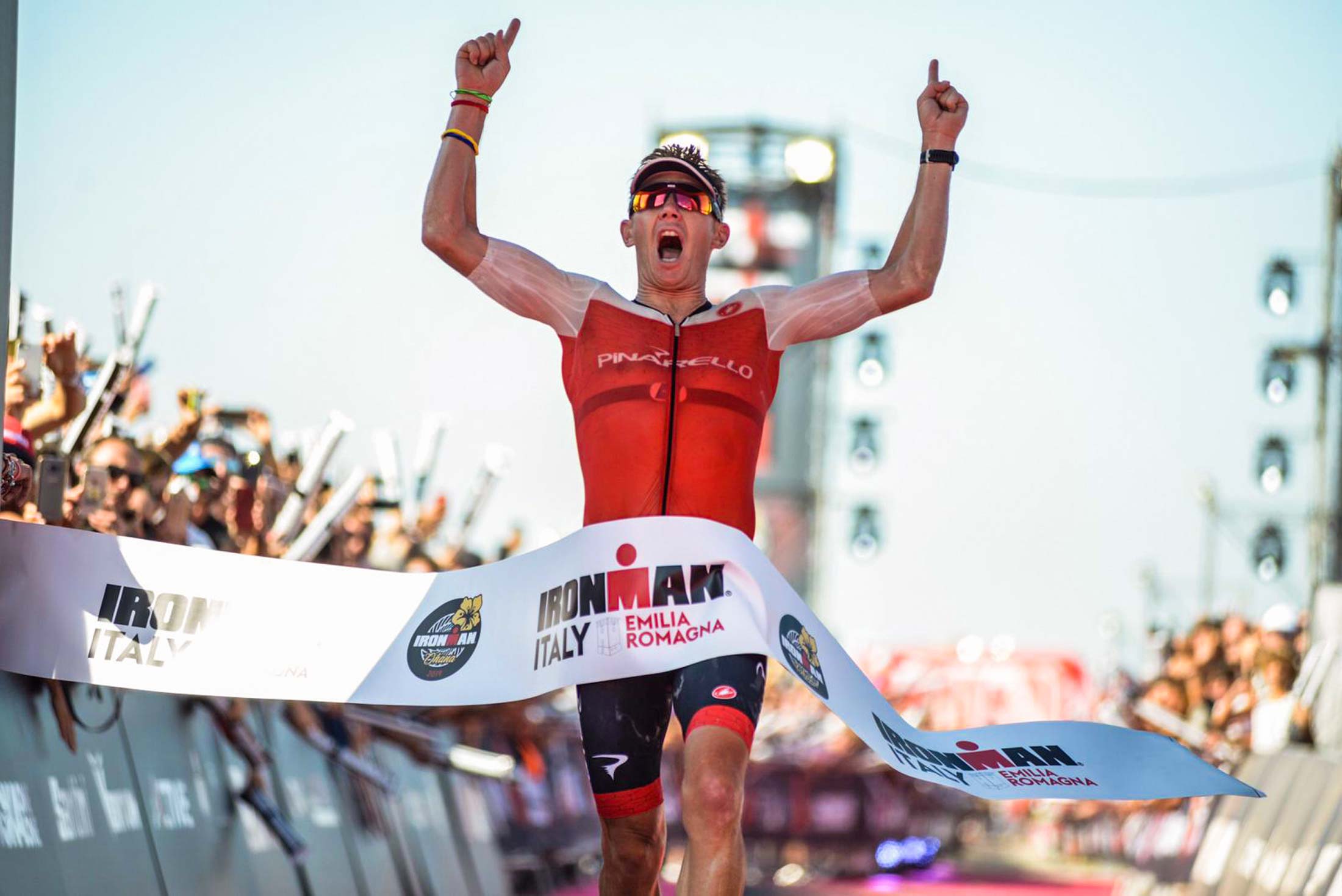
Wurf wins the 2019 Ironman Italy in 7:46:54, a PB time for his latest sporting undertaking. (His splits were: swim 46:39; bike 4:09:03; run 2:45:02.
Wurf rowed for Australia at the Athens Olympics then an injury pushed him to his second sport, cycling. Surgery on his wrists forced him to take a break from the boat but he wanted to keep active. Before he knew it, he was racing for Australia at the 2007 worlds and had signed a pro contract.
“There’s not a lot of money in rowing,” he told me back then. “There’s enough to help you focus on your training, but it’s not like you can retire on the profits.”
Cycling gave him a chance to compete and make an income but even 12 years ago, Wurf said his interest in pro sports wasn’t about trying to get rich. “My motivation for cycling is not about money,” he laughed. “If I wanted to earn a comfortable salary, I’d use my degree and get a job.”
And so he raced. He did reasonably well. He finished three Grand Tours – the Giro (2010 and 2013), and Vuelta (2013) – and got decent results over the years but he never won a pro cycling race.
Although he loved it, Wall Street seemed a better fit and his cycling life started to fizzle out, until that call from Kerrison and the “last hurrah”.
Those “10 days training” in early 2017 continue to this day and there’s no clear end to the training relationship that helped spawn another sporting career. The triathlon thing is, in part, Froome’s idea and it was accelerated after he and Wurf rode together those first few days.
“When I was with Kerrison and Froome, I was able to handle the work and cope better than any of us expected. And so,” says Wurf about the end of that original session in 2017, “they posed the question: ‘Why don’t you take this triathlon thing seriously?’ That was how it all started.
“I did a couple of training camps with Chris: one in Tenerife and one in Châtel, which was really the turning point. That was the middle of the year and I was trying to qualify for Kona. Tim said: ‘If you can qualify, it’ll give us a huge amount of intel…’ I needed second place in an Ironman to qualify and there was one opportunity left.
“Chris called me immediately after winning the 2017 Tour de France and said he was off to Châtel for a couple of weeks and asked me to join him on a training camp as he prepared for the Vuelta.
“We did probably the craziest week of training ever, which is pretty mind-boggling because you get all these stories about after the Grand Tours, where guys do nothing. When I’d done one, I certainly didn’t want to do anything… But, here was Chris, training even harder than in January, only a week after the Tour to get ready for the Vuelta.
“I was tagging along and didn’t want to slow him down so I was working pretty hard and getting the benefits too. I went off and did Ironman Sweden the day he started the Vuelta and came second – and qualified for Kona.
“Chris told me before I left, ‘Listen mate, you don’t have to do anything more than you’re capable of doing because you’re more than capable of achieving what you want to.’
“It’s probably the best advice I’ve ever been given in sport because I’ve always had this thing about racing, where you need to over-perform. If you put that kind of pressure on yourself it doesn’t happen. The work in training sets you up and racing almost becomes easy. Chris was the one who really taught me that and I owe a hell of a lot to him.”
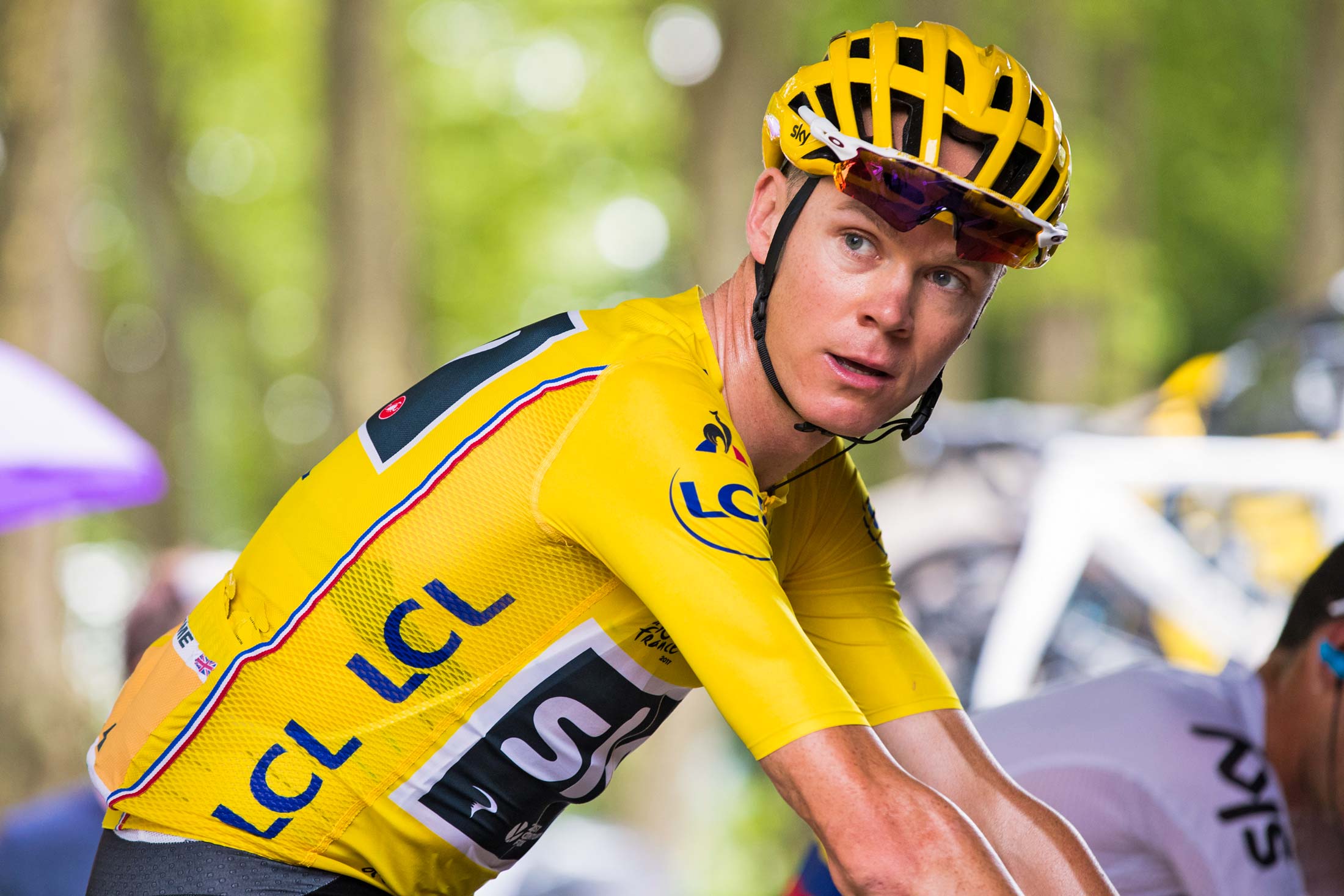
Froome at the Tour de France in 2017. He would go on to win three successive Grand Tours: Tour (2017), Vuelta (2017) and Giro (2018). Photo: Léon van Bon
It’s an arrangement with many benefits. Kerrison gets his intel from physiological tests. Team Ineos has a substitute rider for training camps. Wurf hones his form and prospers in his third sport and, as October approaches, he relishes his status as one of the favourites for the Kona Ironman.
“I’ve lost the race both years in the run,” Wurf says of the Kona campaigns of 2017 and 2018 when, both times, he set records for the bike split.
“I’ve led into the run and have had a lot of criticism thrown at me, that I’m a cyclist… so, of course, I’ve just gone to Kona to try and prove I’m the best cyclist – with disregard to the race. And that’s rubbish!
“Of course, I do ride as fast as possible because that’s my opportunity to win. I’ve put myself in a position to do that but I obviously haven’t been a good enough runner.”
His rapid progression in triathlon is boosted by the work he does with Froome and Kerrison which also helps on a number of other levels: phyiscally, mentally, and financially.
“I’ve never really been in a position where I’ve consistently had success. It’s an awesome feeling and I want to keep my foot on their throats if I can.”
Wurf’s shifting personal ambitions allow him to look at sport from the outside, with a fresh perspective.
“I think the reason I’m performing better in triathlon than I did in cycling is that I’ve got that real hunger back… I didn’t get many chances to win in cycling,” he says, before quickly correcting himself: “Rather, I just wasn’t good enough… So it’s great to have that winning feeling back.”
Serendipity steered him towards the lava fields of Kona and another sporting challenge and Wurf approaches it with gusto.
He did eight Ironmans in 2018: a 3.8km swim, 180km bike, 42km run, over and over and over again… He’s actually lost count but believes his total is “15 or 16” in two years. “It’s certainly a lot more than most will ever do in their career… it all happened quite fast.
“The lessons from that last transition have helped me in this one,” he says of the switch from rowing to cycling.
“You’ve got to learn how to race… There’s no way around it: I didn’t have the years as a kid, racing triathlons, so I’ve had to learn on the biggest stage – a bit like I did in cycling – which can be daunting but because I had the experience before, I’ve been able to handle it.”
Keeping up with Tour champions
There’s a lot of science behind the work done by Team Ineos but, as analytical as Wurf is, he admits he can’t share much insight from the data collected from training sessions with Tour champions. His amazing physiology allows him to ride hour after hour with Froome and Thomas, et al, but he does what’s prescribed… then moves on to the next task.
It’s exercise, but done in a way few would be able to cope with, even someone with Wurf’s capacity for suffering.
The pre-Vuelta training camp in Châtel convinced Wurf that the approach had merit but he’s hazy on detail when I ask for specifics of that “craziest week of training ever”.
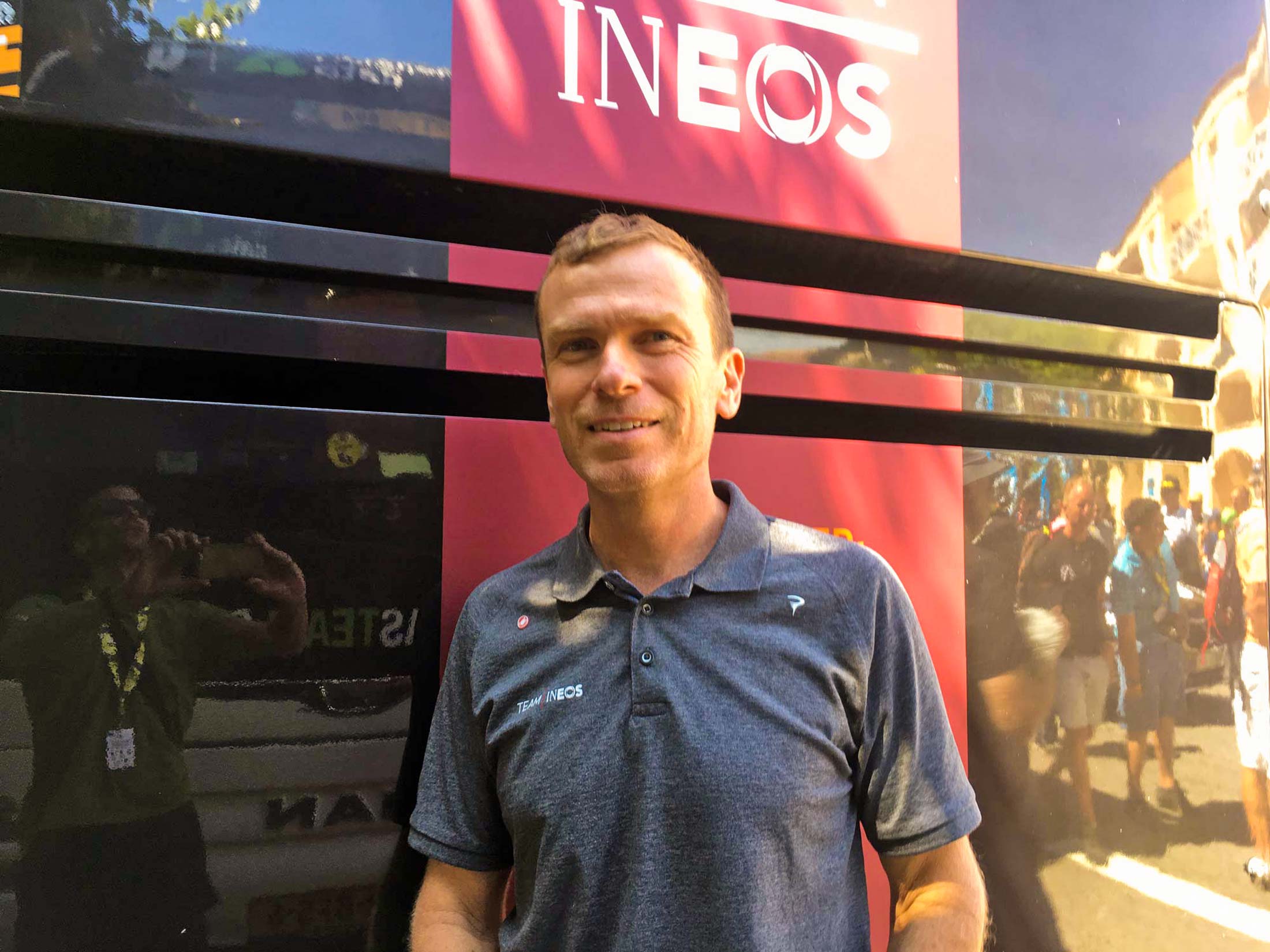
Tim Kerrison, one of Wurf’s biggest supporters, at the Tour de France in 2019. Photo: Rob Arnold (See interview, from stage 5 on ridemedia.com.au)
“We did about 40 hours of riding, around 25,000-plus metres of climbing, and to finish we rode from Châtel back to Monaco.”
It’s a journey of around 600km and they did it the hard way, via the Alps and onward to the Mediterranean.
“We rode to the Galibier on the first day and actually stayed on top. That was over eight hours and we finished the rest the next day. It was pretty crazy.”
Having Wurf around helps break up the monotony and not only because he’s a good talker. He’s helping the cyclists but there’s also his new sport to consider.
“Tim would have my shoes and swimming gear in the car, in case we went past a pool or something. He’d drop me off, I’d swim, and Chris could go and do some intervals for a few hours.
“Then,” he continues about sessions with Froome, “we’d go past a lake and Chris would want to stop and swim… it was an incredible period for me, a self-realisation that I’m capable of achieving something in a sport I’d given up on. Chris is the fundamental part that gave me that self-belief.
“When we did that eight-hour day we actually started on the TT bikes and it was satisfying that, after about four hours, he started getting sore and tired and wanted to change bikes. And I still felt great.”
Wurf has good insight into how Tour winners prepare for their job. Success comes from honest graft, meticulous planning and determination like he’s not seen in other riders. There are also specific efforts designed to replicate race conditions, and the triathlete plays his part.
“He’s a very honest guy and a hard worker,” Wurf says of Froome. “Really, there are no secrets: just hard work.”
One session in Châtel involved a race simulation for the Vuelta. “We had one point where I’d go ahead on a climb. Chris would do a solid effort that would catch me. Then I was to pace him across a flat section… I remember coming through an intersection and Tim was with the team car, stopping traffic, so we didn’t even have to slow down. I led him into a wall of a climb which was similar to what he faced in the Vuelta, and off he went. I took double the time to get up this climb than it took him… I was so exhausted from that effort, but I understand the benefits.
“To watch Chris at the Vuelta a couple of weeks later on the particular stage we were practising for, where he’d take the leader’s jersey, was like, ‘Wow!’ If you can do it in training, it just becomes inevitable in racing.”
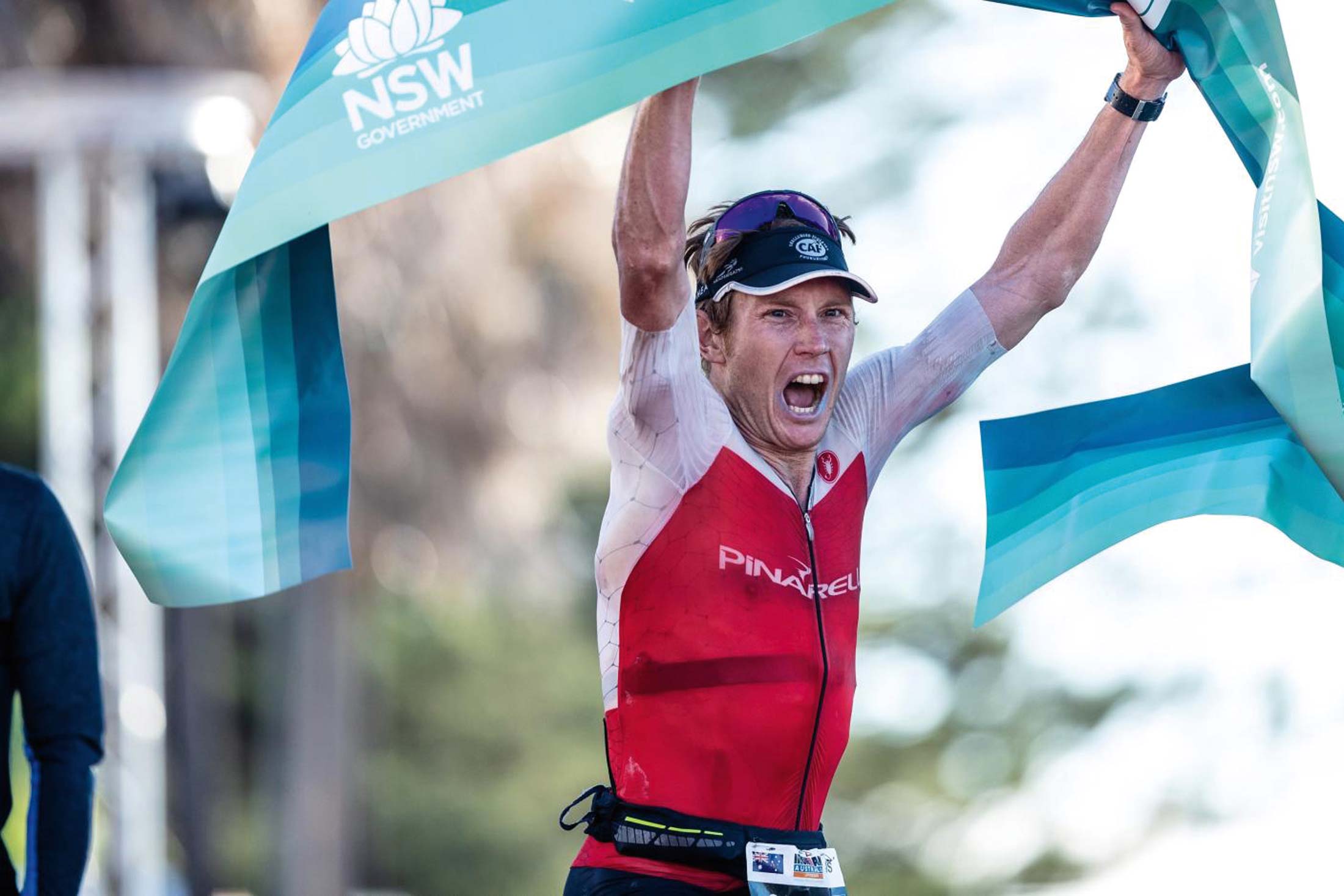
Wurf set the course record for the Port Macquarie Ironman with his win this May: 8:06:17. Before taking up triathlon, he was racing as a pro cyclist with Cannondale.
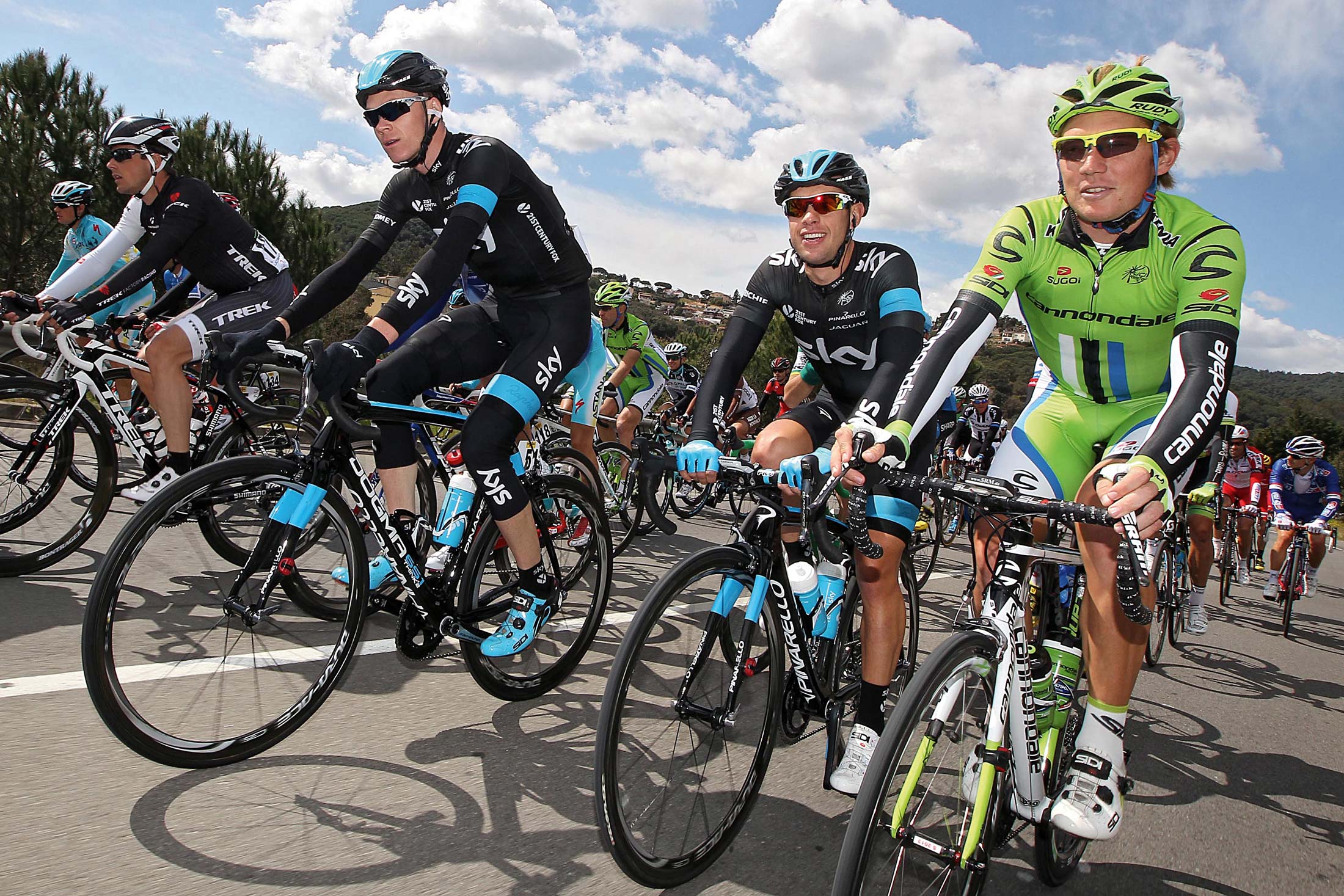
Wurf confesses that he can’t remember every detail of the tasks imposed on them by Kerrison. “I wish I knew the specifics of the training,” he says when I push for more details on data, “but I don’t remember everything because I’m simply trying to survive every effort.
“If I think back to racing compared to now… I was so engrossed in the training. I knew everything. I was always analysing it. With Kerrison coaching and Chris as my riding partner, I simply do what I’m told. When that’s done we move on to the next task. Honestly, I can’t even remember what we did after the warm-up.
“It has certainly been a quantum shift for me in the way I approach sport and it’s more of a simple approach than it being more complicated and technical, which others might assume of that organisation.”
Developing product… and friendships
“At the end of 2017, we talked about just putting me on the team but then it seemed better to maintain a status quo – considering what I needed to work on [for Ironman], and that isn’t my cycling.
“I’m treated the same as the other guys who do the training camps, with all the support from staff and whatever else I need, but I also have a bit of flexibility where I can test [equipment] and do other things, and that’s been really beneficial for me.”
Wurf has helped Pinarello develop TT bikes and that commercial relationship continues to prosper. Lessons from triathlon are helping the cycling team, and vice-versa.

“Training with the guys, and earning my stripes with them has maybe given more credibility to the testing I’m able to do for [the team] and Pinarello.”
Wurf’s first record bike split in Ironman was set in 2017 on a bike borrowed from the team: 180km in 4:12:54 (an average speed of 42.764km/h, after the swim and before the marathon).
“Afterwards I got an email from Fausto Pinarello saying how pleased he was that that had happened. He said, after all the success that they’ve had at the Tour with Bradley and Chris, and with Bradley’s hour record, he was thrilled to now add the Ironman record to the brand.
“I never thought I’d see my name in the same sentence, let alone be compared to those performances, and [Fausto] finished by saying, ‘We’d love to develop a bike with you…’ That was pretty amazing for me, it’s something I’d always dreamed of. I’m a pretty big dreamer. A lot of these dreams I never really believed were going to happen but – for some crazy reason – they all seem to come together.
In 2018, Wurf beat his own record bike split and posted 4:09:06 for the 180km TT on the day of the fastest Ironman at Kona.
“I had some good success and they’ve had huge success with the sale of it which is an important thing. So yeah, I’m a big fan of Pinarello…
“You want to surround yourself with the best people and I’m really honoured by the people I have around me. Obviously, being included in [Ineos] is huge for me. And everything that goes along with it. For it to be taken a step further and developing products with their partners… you use the words ‘a dream come true’ but I couldn’t have even dreamed of my current situation like it is.”
Diversity… and winning the Tour again
Tim Kerrison, a Queenslander who worked in swimming before eventually finding himself on the staff at Team Sky, is a coach who deserves a lot of the credit for the successes of Wiggins, Froome, and Thomas at the Tour. Pro cycling is what pays him a salary but he often looks elsewhere for training methods that could benefit his riders.
Wurf is more diverse than most athletes, he’s also got a unique energy that allows him to push himself to extremes. Nothing seems to slow him down. I called to congratulate him a day after his Australian Ironman win and Wurf just panted back, “Can I call you in a few hours? I’m doing a bit of a run to stretch the legs.”
When we do speak, I ask if he ever stops and reflects on all that’s happened in the 20 years he’s been an athlete.
“That year I had in between sports – when I stopped racing and went to America with Cannondale and they basically didn’t make me do anything – that was the worst! I lasted until about June/July without an objective and I just hated it. I couldn’t stand it.”
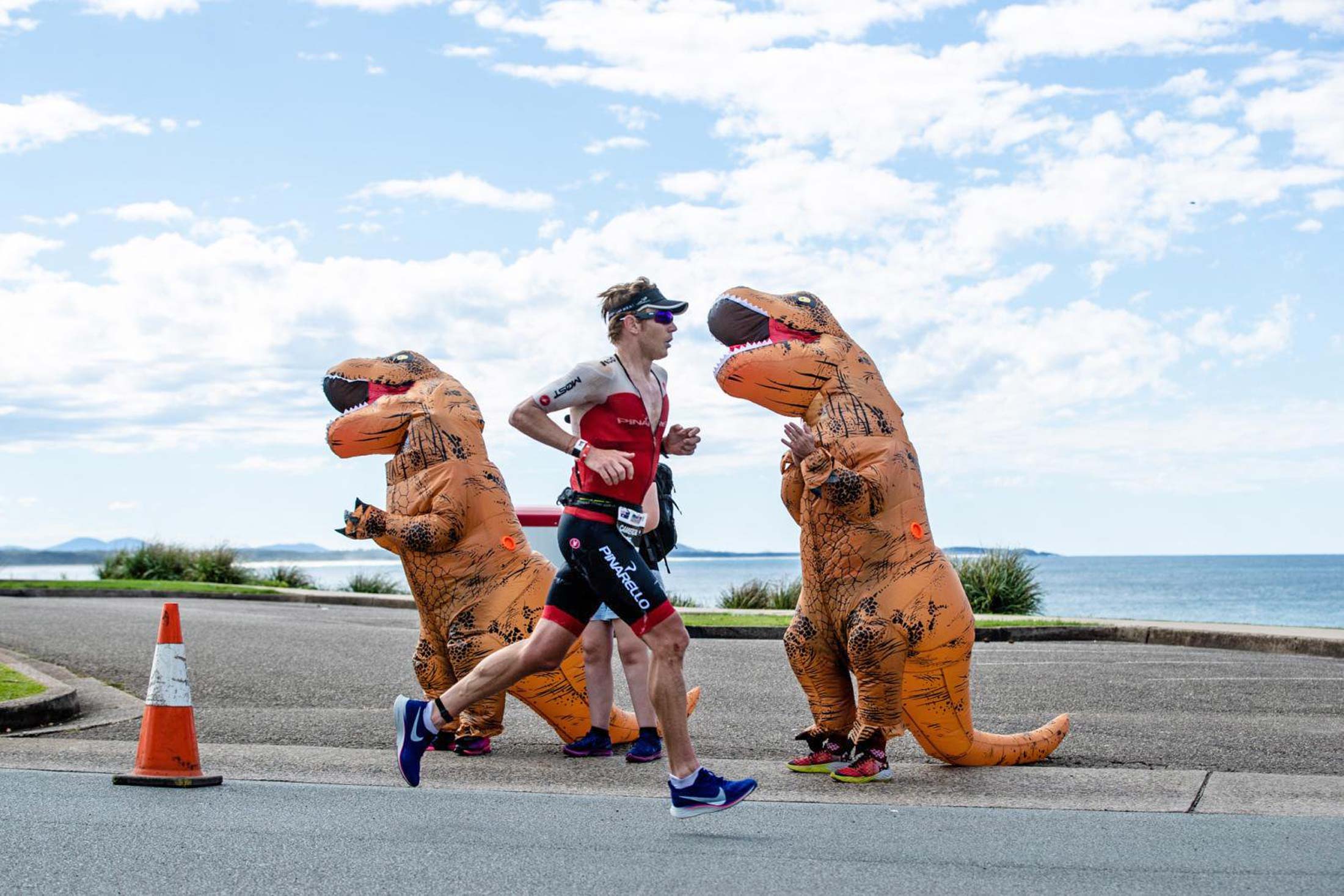
He had jobs to do as an ambassador for the company that sponsored his final WorldTour team but the idle life didn’t agree with someone who has always been active.
“I always thought semi-retirement would be amazing, being able to choose to do what you want to do but for me, it redefined what I perceived to be retirement.
“Retirement will be getting myself to a point where I can choose to do what I want to do,” he says.
“Part of that is having a purpose, an objective towards something.
“I don’t think I could ever not have a goal.
“It doesn’t even matter what it is and I guess the current obsession with improving my run in triathlon is a great one because I tend to have a fair amount of energy, so I’m learning how to run.”
He laughs and continues: “It occupies me and probably takes the edge off because it really takes all of my effort to have gotten to where I’ve got with that.
“There’s no doubt that I use sport to deal with a number of conditions that I might have underlying.”
* * * * *
Rowing, cycling, swimming, running… he’s tried all of them yet he expects that, inevitably, he’ll end up working in finance. Sport has given him a lifestyle and his enthusiasm for exercise means he rides with some of the best cyclists in the world… while training for his triathlon objective.
But there’s more to Wurf than training and competition. He is analytical, articulate, and able to work with a range of professionals all over the world to get the most out of what he says is “pretty average ability”. He does this with an infectious enthusiasm. Coaches, athletes and product developers have benefitted from his input and although he left pro cycling years ago, he continues to have an influence on the sport as a proxy member of a team that has won the Tour’s yellow jersey six out of the last seven years.
Aside from responding to the original request to be a ‘training partner’ for Chris Froome, what is Wurf’s role on the team and what has he learned about Ineos and its long list of stars? Can he give an overview of how he thinks they’re going to fare at the Tour in 2019?
“Even as far back as 2017 Tim Kerrison said to me that part of having me involved – and his interest in me being a test dummy – was about creating a sporting organisation that could apply its knowledge to a range of things. As you’ve seen, that’s basically what has happened with the arrival of Ineos and meeting Jim Ratcliffe.
“He’s got the America’s Cup team. I believe he’s close to buying the Nice football club. He’s funding the ‘Breaking2’ project with Eliud Kipchoge and Kerrison is working with Kipchoge…” There’s a lot going on and the cycling element is one part of the broader investment into sport by Ineos.
Lessons from riding with champions
The team faces the challenge of deciding who will be the leader in 2019 and there are options beyond the two who have already won, so it makes for a compelling situation.
“Chris has won the Tour multiple times but no Grand Tour has he really ever done the same way,” Wurf reminds me. “That shows what a great champion he is, in that he always finds a different way to win.
“Geraint has already won [the Tour] once and until he wins it again, we don’t know if he’s got the capacity to win in different ways but I’d say Geraint is the more complete rider… of the Tour winners I’ve gotten to know – he has the potential to be a very difficult champion to topple.
“Judging by their ability – and the workload and their work ethic – and the way that the team is structured, with these extended resources which branch into other sports at the highest level of performance, I can see Ineos being very successful… in a different way to Team Sky.
“I think it’s very exciting for the sport. Who knows, it might be like when they started, they might have a couple of years where they have a few whoopsies. But if they get it right – and you’d have to back them to do that because of what they’ve done that so far – I think it’ll be really exciting to see what happens over the next few years.”
Wurf has a unique undestanding of the strengths of the riders on Ineos. So I ask if he can explain any detail of the training and if others on the roster impress him as much as Froome and Thomas. When they’re doing the reps up Mount Teide is there a sequence? Does everyone just go on their limit? Do they ride together? Do they have intervals? Can he compare others in the line-up? Has he, for example, ridden with Egan Bernal? Is he the next Tour champion…?
[We now know the answer, but this was published before the 2019 Tour. Rob]
A lot of questions spring to mind but what I essentially want to know is: just what is it like watching these guys doing work in an environment few others get to see?
“I’d have to say that, when you’re training with them, Chris and G obviously standout but the reality is, when they’re training, they’re all pretty similar.
“Wout Poels can go just as fast, if not faster in things. [Michel] Kwiatkowski can certainly go faster in certain situations. And then you’ve got the young guys like [Pavel] Sivakov and Tao [Geoghegan Hart] and Bernal who can definitely go fast because they’re young.
“But the difference I see – and this was a transformation in G last year which gave me a fair bit of confidence that he was going to win the Tour – was that he and Chris turn up to work every day and just get it done. It’s not always pretty. They’re very often tired and exhausted and all that. But there’s never compromise with those two.
“They take the good days with the bad and I guess they narrow the gap – more than anyone I’ve seen in the sport – between a good day and a bad day. And that’s what you see in a Grand Tour, why they’re so consistent. It’s interesting. There’s not a lot of difference; everyone can train hard, particularly on that team…
“This year I’ve actually spent a lot of time with G in LA, and Monaco more recently. But in Andorra I train with Pavel Sivakov a lot of the time and he’s recently had a great win in Trentino. When I spoke with Tim after that race he was in the car with one of the mechanics and they were joking about how Sivakov’s now going to win everything because, it seems, that who I train with does quite well.”
Wurf laughs about it but doesn’t linger on the thought too long because we’re talking about the Tour de France, and the team that’s trying to win it for a seventh time.
“They’re all strong,” he concludes. “I’ve learned that the big difference between the big champions of the team and the rest of them is more just the mental application. And I can extend that to Richie Porte and other guys in the peloton as well… there’s definitely a difference there.
“I don’t know how you train for that, but Chris and G certainly have that when it comes to racing.”
Benefits of being calm
One of the strengths of Froome and Thomas is that they are able to manage stressful situations.
With Chris, I suggest to Wurf at the end of our chat, it’s wisdom and experience. The same also applies to Geraint, as he’s been through all sorts of scenarios in half a lifetime of being a pro cyclist. But, I say, it seems that G gets through it by basically being carefree, and it’s a pretty blessed way to find yourself when approaching a challenge like the Tour.
“Yeah,” agrees Wurf, “he doesn’t care about anything else that’s going on around him. Obviously he is also very approachable and down-to-earth, the guy that you feel like you could happily sit down with and have a beer with. That’s exactly the type of guy he is but, at the end of the day, he’s always entirely focussed on racing when he has to be and achieving what he’s set out to achieve. He only worries about enjoying the moment once the job is done.
“When he says he just stays in his own bubble, he does. But that’s not like a brick wall around him, he knows what he needs to be focussed on and knows what’s important. It goes back to what I said about training: we are so focussed on whatever we’re doing at that moment that nothing else matters. It’s about switching on when you need to. You can waste a lot of energy on little things.
“I remember when I was racing Grand Tours and I was exhausted from unpacking my suitcase and worrying about what I was going to eat and worrying about how much sleep I didn’t get. Worry about all these things, is stuff those two never even talk about. They don’t waste energy there.
“Chris’ biggest quality is his ability to push himself once everyone else is suffering and to know that there’s something there on the other side – and that’s something that Tim has highlighted about his application, which he hasn’t seen in anyone else. Both of them possess strengths you certainly don’t see in many other riders.”
The passive exterior masks determined athletes within. The lead-up to the Tour of 2019 suggest that Froome and Thomas are comfortable knowing they will work for the one who is stronger in July. It’s going to be intriguing to see how Ineos manage the luxury of a glut of talent.
One of the key team members won’t be racing but come October, we can be sure that Ineos will be tuning in to see if the work they’ve done with Wurf will net an Ironman win. Who knows, maybe one day we’ll see him go head to head with his mate who has won four Tours de France…
“We did a charity event in Miami last year and he was asked the question,” Wurf says of Froome, concluding our chat. “And yes, he’d definitely like to do an Ironman towards the end of his career when he’s still nice and fit. So, I’m sure now, when he jumps in the pool – or in the ocean or a lake – he actually thinks a bit more about his technique and starts to plant some foundations for, who knows? Perhaps an assault on Kona of his own in the future?”
– By Rob Arnold


